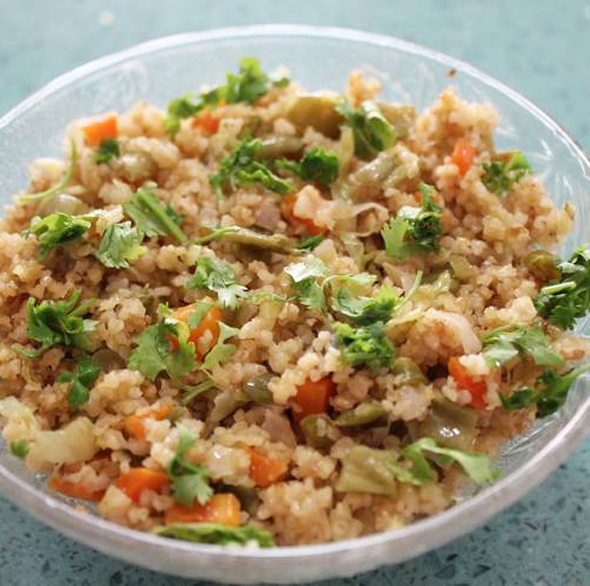Mama’s Punjabi Recipes: Daliya Palao (Cracked Wheat Pilaf) Slow Cooker Recipe
Daliya is nothing more than cracked, roasted wheat, but it is not so easily available in many stores as compared to coarse wheat flour or even suji (semolina); though it is not very expensive. Cooking with daliya requires a little patience, since it takes longer to cook than regular rice; but unlike rice, it is not usually eaten as a base to accompany other food. Rather, it is best appreciated when it is cooked with other vegetables, like a pilaf or as a porridge.
When daliya is cooked sweet, it is in the form of a popular breakfast dish downed with hot tea of warm milk. But Indian palates can just as easily eat daliya salted with other ingredients, much like a rice palao, at breakfast or at any time of day. The advantage over rice palao is that daliya has much less sugar than rice (especially the white variety) and so is better alternative for those who have to watch their sugar or are diabetic.
Since the daliya grain is thicker and denser than rice grain, it usually takes longer to cook. For this reason, it more convenient to make it in a slow cooker that allows the daliya to simmer over a long time. This allows you to take care of your other activities while taking the guessing out of the preparation.
The slow cooker is very convenient for cooking ingredients that will take several hours to simmer and become easy to chew and digest. You can cook for several hours or overnight without concern for overheating or burning the food; yet the design of the slow cooker makes it safe for cooking for long periods.
Ingredients :
1 cup daliya (cracked wheat)
5 cups pani (water)
2 tbspn olive oil
1 small tamater (tamato) – cut into medium-thin half-slices
1/4 cup matter (peas) – fresh
1/2 cup phul gobi (cauliflower) – fresh
1 medium aloo (potatoes) – peeled and large cubes
1/2 cup gajjar (carrots) – peeled and
1 large piyaaz (onion)
Spices: namak (salt), garama masala, lasan (garlic) powder – to your taste
Directions:
1. Pour 1 cup of daliya into 5 cups of water in the slow cooker and turn it on the high setting for an hour.
2. Check to see if the daliya has become a little tender then add the vegetables and oil and leave the setting on high for 30 minutes.
3. Open the slow cooker and check if the daliya tender and cooked. If it looks like there is too much water, let it cook without the cover on low, since the steam needs to rise off.
4. When it is cooked, sprinkle with garam masala and garlic powder before serving with achaar (pickles) or dahin (plain yogurt).
MAMA’S TIP OF THE WEEK
USE AND REUSE KITCHEN SERVING CLOTHS
Living in the US can force you into using lots of paper towels while cooking or cleaning up. Although this is can become a habit, most of the time, using a soft, clean cloth to handle hot pots and pans as well as while making fresh, hot rotis (flatbreads) is just as convenient. In Punjabi, these are called paundas (you have to roll the “d”, with a slight “r” sound) and are commonly used in kitchens.
Paundas are also good for the environment as you can reuse them. The trick is not to throw these in the washer with the rest of your laundry. An ultimate, environmentally friendly idea is to collect all the small left over pieces of hand soap; throw them into a pot of boiling water, throw in all the used kitchen cloths and let the water boil for a few minutes. Then, let the cloths soak for a while, stirring often; then throw out the water and rinse. The cloths should be clean enough to be reused!
Shakuntla Malhotra is a skilled cook of Punjabi dishes made in the old-fashioned style that she learnt as a young woman in her ancestral home in Lyallpur, India before it became part of Pakistan after the Partition in 1947. People have often admired her cooking for its simplicity and taste that comes with each mouthful. Even in her mid-eighties, she continues to cook daily and agreed to share some of her delectable Punjabi recipes.


